CNA Staff, Jan 29, 2024 / 05:00 am
The 50th anniversary of National Catholic Schools Week kicked off this week, celebrating the more than 5,200 Catholic grade schools in the country that educate more than 1.3 million students.
Celebrated since 1974, this week is marked by special Masses, open houses, and events for students and families. This year’s theme is “Catholic Schools: United in Faith and Community.”
CNA spoke with four different Catholic schools about the creative ways they have fostered their Catholic identity and grown in faith.
‘Knowing by heart’
Our Lady of Lourdes Classical School, a K-8 school in Denver, focuses on classical education coupled with a vibrant parish life. With a waitlist overflowing with parish families and other students, Lourdes Classical opened a second campus in 2018. But in 2011, it was a failing school. What changed?
Rosemary Vander Weele, president of the school, credits the turnaround with the “intentionality” of bringing Christ into education.
“Christ is present and he’s the ‘logos’ of every lesson,” she said.
Vander Weele’s goal was to build a “healthy and robust Catholic culture where we could support the families.”
“I wanted to just live up to what the Church asks a Catholic school to be,” she explained, “which is really an integrated presentation of the curriculum through the eyes of the Church in a way that inspires the pursuit of wisdom and virtue.”
Vander Weele credited the growth to “a dedicated and deliberate emphasis on doing what the Church asks us to do, [which] is to support the family in their role as the primary educator” in a way that “honors the end goal, which is the pursuit of wisdom and virtue.”
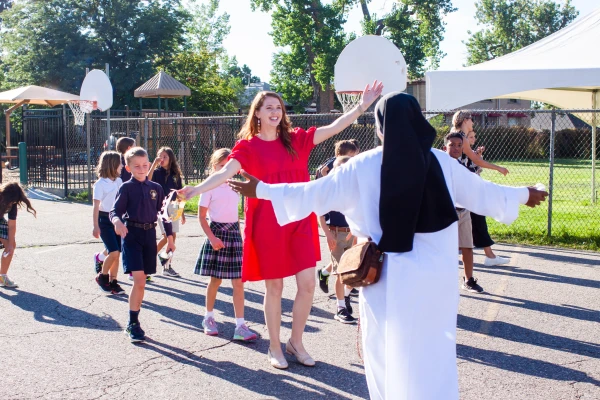
Relationships are at the heart of Catholic education for Lourdes Classical, whether it’s the “partnership” between the school and parents, the support from the parish for the school, or the formation of students by teachers.
“We must be in a partnership [with the parents]. It’s not a contractual thing. It’s a covenant thing,” Vander Weele explained. “We are working together in this mission of forming your students.”
Lourdes offers four daily Masses a week for students, which parents often attend as well.
“There is the element of how critical the parish life is to the support of the school, and that we have seen without a doubt at Lourdes,” she said. “We have an incredible pastor who really brought that vision to fruition … The Masses are packed on the weekends with great families that are not just living the faith on Sundays, but then it carries over into the school life as well.”
Classical education has also played a role in the school’s revival.
(Story continues below)
Vander Weele turned away from the modern, transactional approach to education when she was teaching history and found herself telling a student automatically that the class had to learn this “to get to high school.”
“That was kind of my conversion moment where I thought, if that’s the only reason I am educating, I’m doing exactly what I hated in my own education,” Vander Weele said.
“We remember things when we learn them in story, when we learn them in historical context, and when we learn them in relationship to where we are now,” she explained.
When asked about what classical education is like at Lourdes, Vander Weele said: “It’s not so much classical as it is Catholic.”
“Because if we understand how God created the human mind to absorb, to learn: We say things like, ‘I know that by heart.’ That means we have taken the knowledge, and it has become part of us,” she reflected. “It’s in our heart. That’s not what modern education does. It forces information in and it spits information out, and we have lost the humanity of it.”
“It becomes part of the air we breathe: What we are doing is pursuing Christ, the ‘logos,’ the word, and that happens in every subject,” she said.

Forming the whole student
St. Alphonsus Parish School, a Catholic K-8 school that also prioritizes academic excellence and faith life, has been operating in Seattle for more than 100 years.
Nick Padrnos, who has been the principal for about three years, emphasized that Catholic education is about forming the “whole person.”
“We want to see how things are connected, because once students connect [the] dots of things, there’s those ‘aha moments’ and meaning is made,” he said. “We don’t want to give them this Catholic education where they did robotics club and they did drama and they did CYO sports and they did chess, but they missed the unifying meaning behind everything — which is Christ.”
Padrnos said that a key purpose of Catholic grade school is to help students “develop an appetite for things that are true, good, and beautiful.”
“There’s a lot of cynicism in the world and a lot of our students in this generation, they’re on TikTok or on social media,” he explained. “But I think they’re not as naive as we like to think they are. I think they get the superficiality of it. I think they realize how shallow it is, but it also has jaded them [into thinking] that the world is just shallow.”
“What we’re trying to do is develop an appetite for things that are beautiful, things that are really dense and rich and wholesome that they’re going to have to chew on really deeply and ask big questions,” he continued. “And they’re not going to get all the answers by the time they graduate eighth grade.”
Although only about 50% of St. Alphonsus students are Catholic, Padrnos pointed out that “catholic” means universal.
“If Catholic education is done, right, it should not be a wall or boundary; it should draw everybody in because it’s for everyone,” he explained. “When you get onto campus or into the school building, my goal is that it should feel like you’re swimming in a Catholic worldview.”
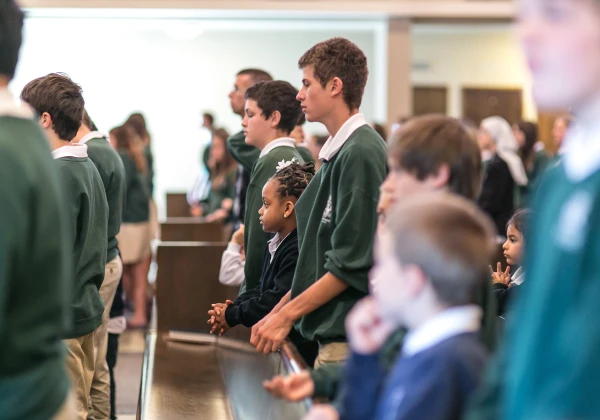
One way Padrnos hopes to instill that worldview is through the school’s “virtue of the month.” Students memorize Scripture relating to that virtue and every week, the school honors students of the week who live out that specific virtue.
“Virtuous living happens every day and we do want to call it out where we see it,” Padrnos said. “The kids need to know that it’s possible — that a life of virtue and holiness can be done, and it should be strived for.”
Padrnos emphasized cultivating the “moral imagination” of students through narrative and play.
“If these students can begin to imagine it, first in story, in the narrative and then really to see themselves as part of a narrative of salvation history that they fit into, imagination then becomes something that’s more real than our day-to-day experience,” he explained. “That’s what we’re trying to give to them, subliminally in a lot of ways, that you’re made for something more. We’re [forming] you to be citizens of this world but ultimately citizens of heaven.”
This year, Padrnos instituted a “house system” where students are sorted into houses named after saints. The “house captains,” who are elected eighth graders, help choose the saints. Throughout the year, the students learn more about their saint, earn points for their house, and join in lighthearted competitions.
“At the start of the year, we did a Harry Potter-style sorting. We found an old hat in the prop room,” Padrnos said. “I got an AI voice generator, typed in like all these little things so that [when] we put the hat on the kid, we’d be in the back and press play on the computer. It’d say [things like] ‘Very interesting… Let me look inside this noggin — ah courage, you must be in the JP2 house!’”
Students earn points for their houses through things like service, altar serving, academic achievements, and practicing virtuous habits.
“It goes to that idea of, ‘I’m not responsible just for myself. I’m responsible for others. My actions have bearing on everyone else,’” Padrnos explained.
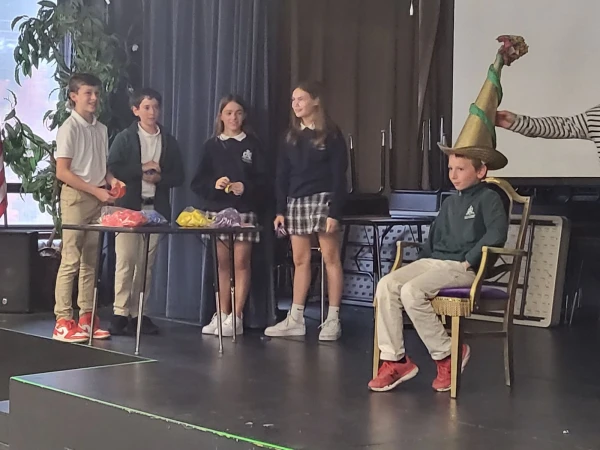
In response to cynicism, Padrnos hopes to instill a sense of play and wonder.
Once a month, St. Al’s has a house challenge where the houses gather in the auditorium and students are randomly selected to play fun games.
“[We do] things like putting shaving cream on teachers’ heads, and kids throw ping pong balls to get them stuck on the teacher’s heads,” Padrnos said. “What does that have to do with the Catholic worldview view? Probably not inherently that much, but again, let’s play into that sense of play, because kids need it.”
“We don’t want the kids to be more mature than they need to be. They’re supposed to be young and there’s something beautiful about keeping that innocence,” he said.
‘The Sacred Heart family’
Another K-8 school taking faith and community seriously is Sacred Heart Catholic School in St. Petersburg, Florida. It also has a “house system” where students and teachers are assigned to groups named after saints. These “houses” each focus on a core value of the school that relates to the saint.
“I’m part of the St. Teresa house,” the school’s principal, Nicole Wilson, told CNA. “So, for example, St. Teresa is ‘serve.’ So my house, our core value that we focus on is ‘serve.’”

Each month, the older students will work on a service project together and the school will tie it to a fruit of the Holy Spirit and a saint that they’re learning about that month. Eighth graders will also pick a charity to help each month.
“We try to do different service projects throughout the school year that are meaningful to the kids,” Wilson explained. “In December, we did Toys for Tots to tie it to Christmas.”
“We like to say that we don’t just have religion class, because it interweaves itself throughout the day,” she said.
When asked what makes Sacred Heart unique, Wilson noted that 90% of the student body (about 226 students) is Hispanic.
“So we have a really big, diverse Hispanic culture that spans through lots of different countries, which is really cool,” she said. “And a lot of the families are very proud of where they come from and who they are.”
Because of this, the school started a Hispanic heritage month celebration and hosted a lunch where the families contributed different foods for the kids to try.
“But it was really cool because you got to see the parents. They had set up tables. They brought fun things for the kids to hand out, and you could just tell how proud and excited they were,” she said. “And it was just this feeling of excitement and community and togetherness that it was catching. You couldn’t not be excited about it.”
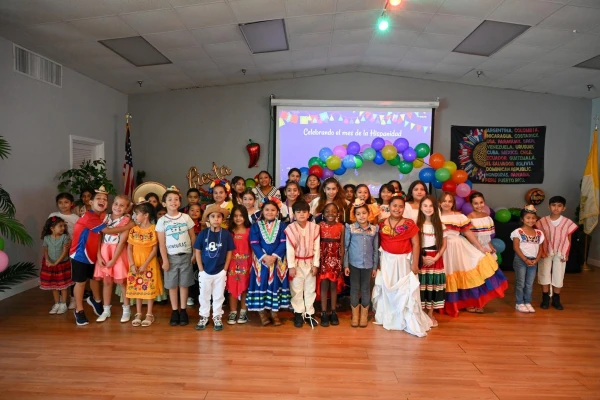
The school has a large number of Catholic families, Wilson noted, but whether you’re Catholic or not, “I have had a lot of people who say that when they walk in the building, it feels like family.”
“I want them to feel welcome, like they’re part [of a community],” she said. “And I always call Sacred Heart ‘our Sacred Heart family.’”
Florida’s school choice scholarship program helps many of the families attend Catholic school, as many are of lower socioeconomic status. This school year, it was no longer income-based.
“When it was income-based, I only had six families that were not on scholarships,” Wilson explained. “So [we] have a very low socioeconomic population.”
“And it’s huge. It really helps a lot of our families who would not normally be able to afford Catholic education to be able to be a part of our school.”
Across state lines
Community is a big part of what headmaster Jay Boren says makes the New England-based school where he works — St. Benedict Classical Academy — unique.
“I think the most remarkable thing about our school is our community, is the people,” Boren explained. “A lot of our parents drive a long way every day to get their children to this particular school for this particular education. A lot of them have moved to this area.”
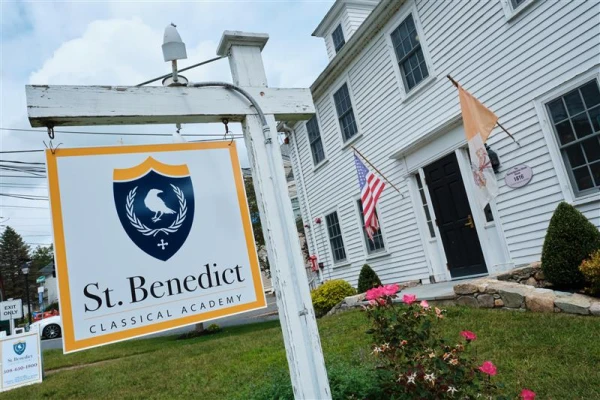
St. Benedict is in Natick, Massachusetts, a suburb of Boston, but the students come from almost 40 towns across two states. Some families make an hourlong commute.
The academy was founded 11 years ago by five moms who wanted a school that was devoted to its Catholic identity with a rigorous academic program. Since then, the school has grown from about 25 students to more than 250 students and broke ground last year for a new campus.
Boren cites two key factors for their success.
“I think it’s twofold: You build a Catholic identity with people, so you have to have a commitment to the mission,” he said. “... We have a commitment to mission, and we’re zero-sum on that. We’re never going to compromise on that. So that is what it is. And then that will attract families who are committed to your mission.”
St. Benedict’s also prioritizes hiring faculty that are “committed to [the] mission.”
“So you have an incredible mission alignment, parent and school, which is really important for the success of the child, the student,” he explained. “We’re seeing a lot of people come to us that probably wouldn’t have come to us five years ago, because they’re becoming dissatisfied with their local public school.”
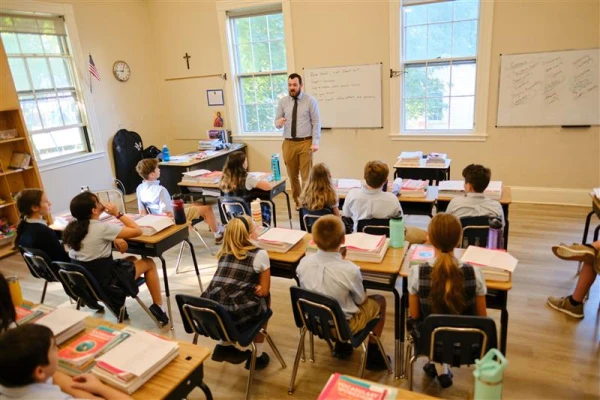
When asked how classical and Catholic education come together at St. Benedict’s, Boren responded: “I would say that for a long time, Catholic education was classical.”
“One of the most important things is how our Catholicism informs the entire curriculum. It’s critical,” he said. “So many times we can see Catholic identity as a cherry on top: ‘We have this really good ice cream and oh, yeah, we have Catholic identity, and we just put it on top.’ And that can’t be the case. It has to inform the entire curriculum.”
Boren explained that the staff prioritizes “secularly virtuous” books and media when arranging the curriculum.
“When we’re thinking about what books we’re going to read in literature class, they’re not religious per se,” he explained. “They’re great works of literature and they’re great works of art and they’re great works of music.”
“Everything that we choose, we choose very deliberately — and they’re beautiful,” Boren explained. “And I think that speaks to the Catholicity of the place. Because that’s what Catholicism uses — the aesthetics — to lift our hearts and minds to God. And I think that’s beautifully interwoven together.”
“If education is a search for truth, well, then it has to end with Jesus Christ, who is truth,” Boren said. “So how that looks in kindergarten versus sixth grade [can] be a little different, but at the end of the day, it has to end there. I think they’re inseparable.”





